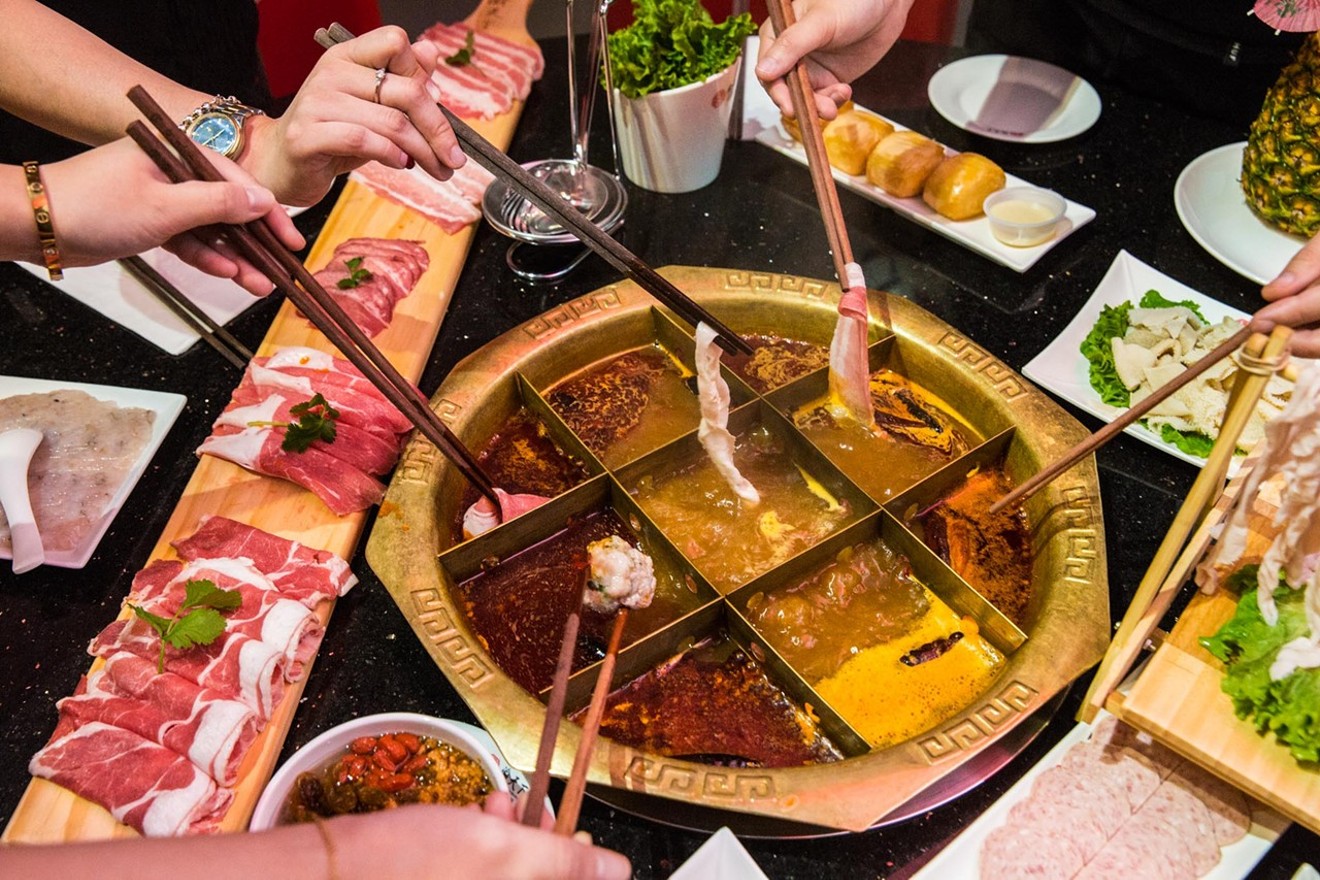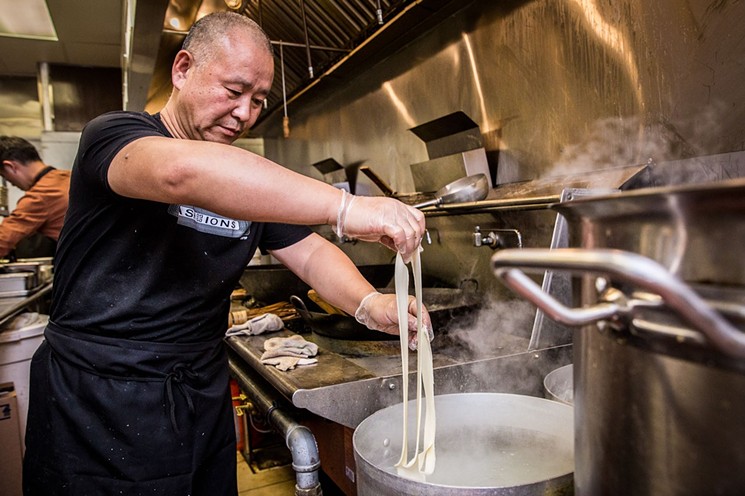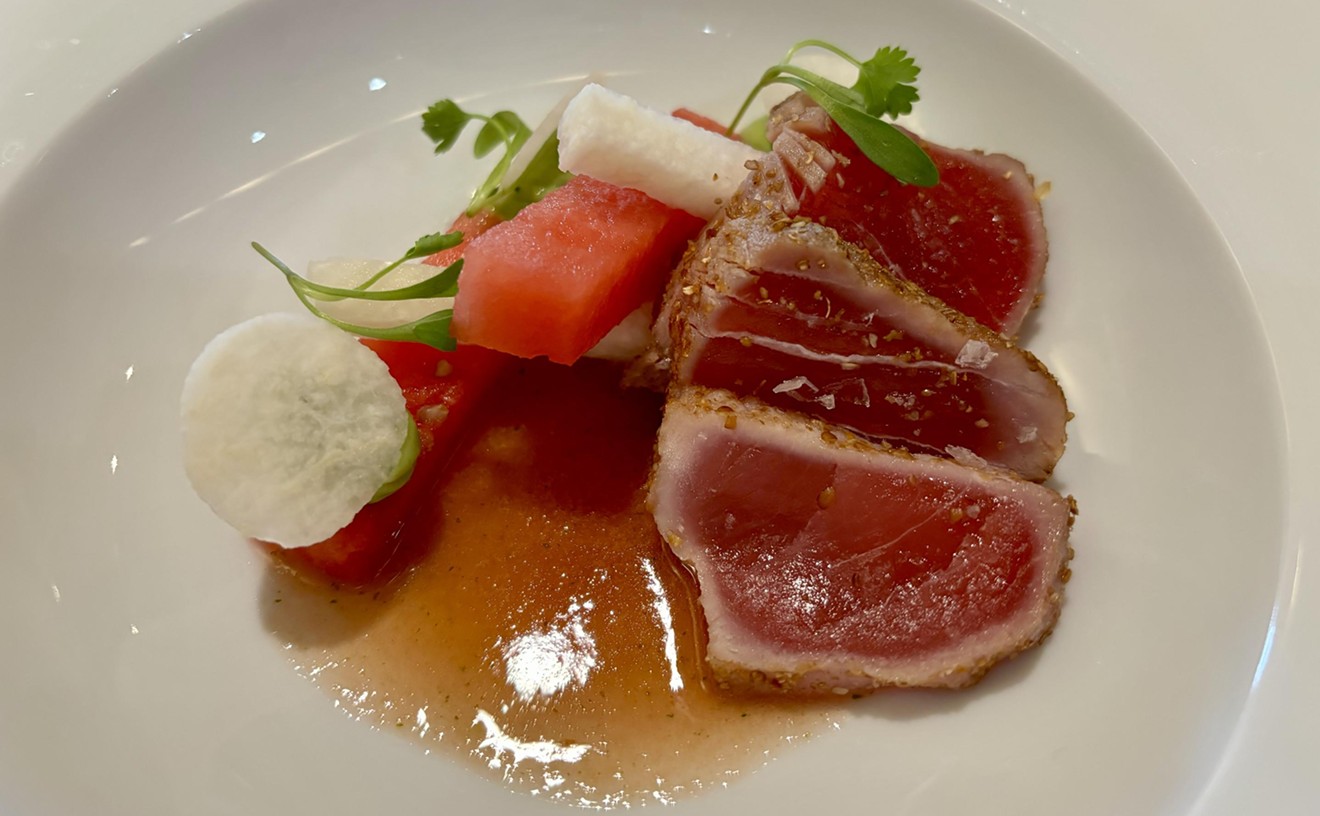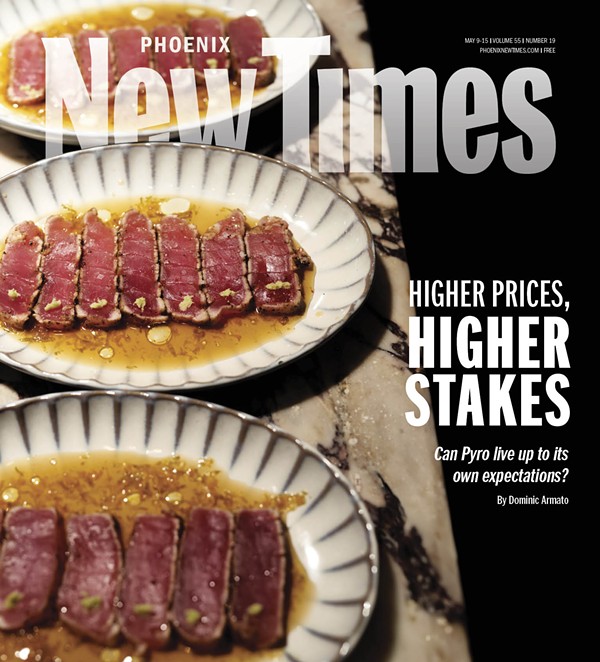“I’ve always had an interest in food,” Adam Yee tells me. “Some might even say it’s an obsession.”
The 26-year-old food scientist — yes, that’s a real thing — picks up a jiggly slice of marinated pig ear with his chopsticks and tosses it into his mouth.
We’re having lunch at Nan Zhou Hand Drawn Noodle House in Mesa, a Chinese restaurant that opened across the street from Mekong Plaza on Dobson Road about three years ago.
Yee pages through the menu enthusiastically. He’s “down to try anything,” he tells me.
Pretty soon the table is covered with dishes: a salad bowl of chile-specked chilled cucumber; a plate of big, sweaty half-moon pork dumplings; and steaming soup bowls filled with Nan Zhou’s signature hand-pulled lamian noodles.
Yee offers thoughtful notes on the dishes: The pan-fried dumplings are bit better than the steamed dumplings. The broth could use more seasoning. The noodles have a nice chew.
Yee is analytical by nature, but also by training. He earned a degree in food science from Cal Poly San Luis Obispo a few years ago, and moved to Phoenix shortly after for work. Today, the boyish-looking scientist is a product developer at Isagenix, the Gilbert-based dietary supplement company, where he designs nutrient-dense protein bars. Some days, he wears a lab coat at work and everything.
When he’s not working, Yee enjoys exploring the Valley’s Asian food scene. A Bay Area native, Yee wasn’t exactly blown away by metro Phoenix’s comparatively modest scene when he moved here three years ago. But he threw himself into the scene, organizing trips to local Asian restaurants with a Meetup group, and documenting his dining adventures on a food blog called “AZ Asian Food Review,” with the goal of finding “the best Asian food in Arizona.” He’s since stopped updating the blog, but only because he’s consumed with another food-related project, a podcast called My Food Job Rocks (available on iTunes and Stitcher), wherein he interviews people with interesting food-related jobs — everyone from food bank directors to food company CEOs to cookbook authors.
About two years ago, around the time that Arizona International Marketplace opened in Mesa, Yee says he noticed a proliferation of interesting new restaurants popping up on the east side. There was the KFC (Korean Fried Chicken) restaurant in Chandler, a new ramen spot in Tempe, and a whole wave of new Chinese restaurants, which seemed to be mushrooming in Tempe, Mesa, and Chandler.
He sounds excited about all the new Sichuan restaurants in town (“Sichuan is exploding!” he says). And the spate of new Chinese hot pot restaurants, such as Yu Tian Xia Hot Pot in Mesa.
“You know, two years ago, there was, like, one hot pot place in Phoenix. Now, I see three of them in one area,” Yee says, referring to a constellation of Chinese-style hot pot restaurants clustered near Dobson and Broadway roads in Mesa.
Yee is not alone in noting the trend. In the past decade, close observers of the Valley’s food scene have watched the East Valley become a destination for some of the city’s most exciting new Chinese restaurants. Many of these restaurants specialize in regional styles of Chinese cooking that were impossible to find in metro Phoenix 20 years ago — or even a decade ago.
The East Valley’s increasingly diverse Chinese dining scene is tied to several factors. Most notably, there’s Arizona’s growing Asian and Asian-American population, along with a thriving population of ASU students who hail from China. It’s a demographic that’s helping to reshape the way we eat Chinese food in the Valley — and changing the metro Phoenix food landscape as we know it.
“A lot of my friends used to complain that there’s no good Chinese food here,” Yee tells me at Nan Zhou in Mesa, in the heart of the East Valley dining corridor that he’s nicknamed “The Dobson Strip.”
“I think my friends are wrong, to be honest with you.”

An array of dishes from New Hong Kong in Phoenix, one of the few Cantonese restaurants left in town.
Evie Carpenter
Even if you take only a passing interest in the metro Phoenix culinary scene, you’ve probably noticed that the city’s Chinese restaurant scene has changed dramatically over the past decade.
Former Phoenix New Times food editor Lauren Saria documented the decline of Cantonese-style cooking in metro Phoenix in a 2015 story called “Wok Away: Cantonese Food in the Valley Soon May Be a Thing of the Past.” Saria’s piece noted the loss of Phoenix Cantonese staples like Lucky King Wah in Phoenix, a restaurant that transitioned to a more mainstream American Chinese menu after it was sold to new owners.
Last year, the Valley’s roster of old-school Cantonese-style restaurants shrunk even further with the closure of Phoenix Cantonese-style staples like Silver Dragon and Gourmet House of Hong Kong.
Cantonese cuisine, of course, remains alive and well at Valley restaurants like Hong Kong Asian Diner in Tempe, and Great Wall Cuisine in Phoenix. And there’s no shortage of restaurants featuring Americanized, Cantonese-inspired cooking — temples of egg foo young, chop suey, and deep-fried egg rolls.
Historically, metro Phoenix has been home to a modest yet respectable Chinese dining scene that’s steeped in Cantonese cooking. One of the oldest culinary establishments in Phoenix happens to be a Chinese restaurant: Sing High Cafe, an American-Cantonese chop suey house on Madison Street, which quietly serves lunch and dinner daily in the shadow of Talking Stick Resort Arena and Chase Field.
Arizona itself has a long history of Chinese immigration. The first Chinese immigrants to the Arizona Territory arrived in the mid-19th century to work in mining and railroad construction. In metro Phoenix, a small Chinatown developed in downtown Phoenix in the 1890s, eventually swelling into a two-block area chock-full of Chinese businesses and residences. Like much of downtown Phoenix’s tangible cultural history, though, most of that historic Chinatown was torn down in the 1960s. Sing High Cafe remains one of the last remnants of downtown Phoenix’s Chinatown.
Although it’s been the de facto Chinese cuisine in metro Phoenix for years, there’s been a pronounced shift away from Cantonese-style cooking in the Valley.
Part of this shift has to do with changing demographics. Arizona’s Asian population, according to several reports, has more than doubled since 2000. According to data provided to New Times by Arizona State University geography and Asian Pacific American studies professor Wei Li, East Valley cities like Chandler, Tempe, and Gilbert have seen the biggest jumps in Asian and Pacific Islander populations.
Asian and Asian-American newcomers are drawn to the area for myriad reasons: good public schools, good freeways, and convenient shopping centers, including a flourishing roster of Asian supermarkets. Some newer residents are drawn to the presence of companies like Intel and Shutterfly, which are contributing to the area’s reputation as a tech hub.
The decline of traditional Cantonese-style restaurants is not just a Phoenix thing, though.
It’s part of a larger national trend, says Jennifer 8. Lee, author of The Fortune Cookie Chronicles.
“Chinese food, given how large the area is, and how old the cultures are, is incredibly big and diverse,” Lee says. “And the food that first came here is a subsection of that.”
In her book, Lee traces the many factors that helped make Cantonese-style cooking America’s first Chinese cuisine. Namely, there’s the fact that much of Chinese immigration to the United States before the 1950s can be traced to the area around Guangzhou (formerly Canton), the capital of Guangdong Province in southeastern China.
To this day, many Americans still associate Chinese food with the food introduced by immigrants from this part of China.
But Cantonese-style cooking, as Lee says, is only a small subsection of Chinese cuisine.
China is home to one of the world’s most vast, diverse, and oldest food cultures on earth. Modern Chinese cookery has been shaped by thousands of years of history, and by numerous cultures, immigrants, ethnic groups, and travelers. The diversity of the food is in part a reflection of the country’s incredibly varied landscape, which encompasses hot deserts, tropical rain forests, low-lying farmlands, and some of the world’s highest mountains and longest rivers.
Modern China is home to both to remote villages, but also more than 160 cities with a population over 1 million. To help put that into perspective, the U.S. only has 10 cities with a population of 1 million or more, according to the most current Census Bureau report.
To speak of “Chinese food,” then, is to speak in incredibly broad terms. It’s a little like trying to make generalizations about “European” food. A food scholar could easily spend a lifetime sorting out the country’s array of food traditions.
Over the years, some scholars have attempted to codify Chinese cooking into “eight great cuisines,” or culinary traditions, of China: Shandong, Jiangsu, Zhejiang, Anhui, Fujian, Guangdong, Sichuan, and Hunan.
But even this framework strains to capture the diversity.
Ken Hom, an American chef and author, has devised a much simpler, stripped-down framework that might be more useful for Americans overwhelmed by the vastness of China and its foodways.
In his work, Hom often divides the country into four distinct regions: the North, known for cold weather and wheat-growing areas, is often identified with buns, dumplings, and other doughy foods; the South, whose hallmarks include warmer weather, rice fields, and fresh, minimally processed, garden-to-table ingredients; the East, admired for its high-quality fresh seafood; and the chili-loving Southwest, famous for the oily, numbing properties of its ma la sauces, which feature Sichuan peppercorns.
In the U.S., Americans are probably best familiar with the foods rooted in pepper-loving provinces like Sichuan and Hunan, along with Cantonese cooking.
But even our understanding of Cantonese cooking is often screwy. Cantonese cooking, in the U.S., is often associated with the ultra-popular, sticky-sweet flavors of Americanized Chinese food. It’s an undeserved reputation. Traditional Cantonese cooking is celebrated in China for its subtle and refined flavors. There, it’s known for its use of wok stir-frying, and deftly balanced sauces made from ingredients like sugar, salt, soy sauce, rice wine, vinegar, scallion oil, and sesame oil.
Historically, Chinese restaurateurs have been forced to modify Cantonese dishes into marketable American fare, thus leading to distinctly American “Chinese” dishes like chop suey.
In 1965, the U.S. abolished the national origins quota system that had shaped American immigration policy since the 1920s. This development fueled a second — and more diverse — wave of Chinese immigration to America. These Chinese immigrants helped introduce bold new flavors and regional cuisines to the U.S. for the first time, including Sichuan- and Hunan-style fare.
Chinese immigration to the U.S., today, is significantly more diverse than it used to be. That means American cities, including metro Phoenix, are getting to taste a wider variety of China’s vast food culture.
Fortune Cookies Chronicles author Lee, who lives in San Francisco, tells me that she’s seen many types of regional Chinese cuisines popping up across the country.
“Notable types include Shaanxi cooking, and specific parts of Chongquing,” she tells me. “And there’s more proliferation of the types of foods that you find in Western China.”
This includes elements of Xinjiang cuisine, from northwestern China, she says, where “Muslim-Chinese” cooking features ingredients like lamb, cumin, garlic, and eggplant.
Are Americans becoming more sophisticated about Chinese food, perhaps the world’s most diverse cuisine?
Sure, Lee says. But Americans are adapting to more than just different types of Chinese cooking.
“Think of all the cuisines that are now quite common here, like Vietnamese, Thai, Indian,” Lee says.
It’s a sentiment echoed by Dr. Li at ASU.
“As metropolitan Phoenix becomes more cosmopolitan, people’s tastes change. People are now willing to taste different things,” she says.
For some hungry locals, this change can’t come soon enough. Metro Phoenix’s Chinese restaurant scene is getting richer and more diverse, but it’s clear that we’ve barely scratched the surface.
Sheila Wang, who owns Dim Sum Cafe in Mesa, tells me she thinks metro Phoenix could really use a Chinese breakfast place.
Yining Tan, a graduate student at ASU who originally hails from China’s Anhui Province, tells me that she wishes metro Phoenix had something like Southern California’s wildly popular 626 Night Market, which is held throughout the year in L.A. and Orange County.
The 626 Night Market, described as the largest Asian-themed night market in the country, is famous for its youthful crowds and long lines, but mostly for its incredible selection of street-style Asian foods.
Eva Zhang, another ASU graduate student who came to the U.S. from China, tells me she’s dying for more hot pot restaurants — and more Japanese and Korean food, too.
“I wish we could have more hot pot restaurants in the East Valley, like Boiling Point and Little Sheep Mongolian Hot Pot, which are very popular in greater L.A. and [the] San Francisco Bay Area,” she tells me in an email.
“I also personally prefer more Japanese and Korean restaurants. Ramen, sushi, beef/pork ribs, and tofu soups are very popular dishes among Asian populations.”
Zhang says she just doesn’t have the stomach for American-style Chinese food.
“The long-existing Chinese restaurants in the Valley are mostly Cantonese style. But Cantonese is a minority group in China, so when I grew up (in mainland China), I had never eaten any of those kinds of food at home,” she explains.
She understands that early generations of Chinese immigrants, trying hard to survive and “blend into American society,” were forced to sell non-Chinese foods like fortune cookies, she says.
For someone who grew up eating in China, fortune cookies can be kind of a bummer, she says.
It can be “frustrating” to see her American friends posting photos of fortune cookies on Instagram, she says. That’s just not the food she grew up eating.
“In general, there is a huge gap between how Americans perceive Chinese food and our perceptions of Chinese food,” she says.
Zhang, though, is a fan of some of the East Valley’s newer restaurants — especially places like Shaanxi Garden in Mesa.
When I tell Fortune Cookie Chronicles author Jennifer 8. Lee that metro Phoenix just welcomed what might very well be its first Shaanxi restaurant, her response is succinct: “Shaanxi? That’s pretty hardcore.”
Shaanxi Garden Restaurant is one the city’s buzziest and most ambitious new Chinese restaurants in the city. The restaurant opened last year in Mesa, and its menu specializes in the cooking of northwestern China’s Shaanxi province, and its capital city of Xi’an.
Two terracotta warrior statues greet visitors at the entrance, replicas of the famous Terracotta Army necropolis of Xi’an. Few expenses seemed to have been spared in the restaurant’s design — the light fixtures, replica warrior statues, and chairs were all handpicked and imported from China. Even the restaurant’s floors are embossed with images that hark back to ancient Shaanxi history.
Noel Cheng, who owns Shaanxi Garden Restaurant with partner Changhai Huang (the two are also the owners behind Let’s Eat Noodles in Chandler, formerly House of Egg Roll), hopes that the restaurant will introduce the food and culture of Shaanxi to a much wider audience.
Both Cheng and Huang are from Shaanxi province, and their new restaurant sometimes feels a little like an informal cultural embassy. When you talk to Cheng, she rhapsodizes about the rich tapestry of history, art, and food that makes up Shaanxi culture. It makes you fall a little in love with Shaanxi, even if you can barely pick it out on a map.
Did you know that the first emperor from 2,000 years ago was born in Shaanxi? Cheng tells me politely via email.
She tells me that Shaanxi is a dry, wheat-growing region that’s famous for its endless variety of noodles. Shaanxi is also associated with the use of ingredients like pork and lamb, and is sometimes described as one of China’s “heavier cuisines.”
In metro Phoenix, like in other American cities, Chinese restaurants have historically been the province of mom-and-pop operations.
Shaanxi Garden, though, is a good example of an emerging new type of modern Chinese restaurant in metro Phoenix: sleek yet also inviting, and gently determined to introduce new flavors and dishes to the city. To that end, the restaurant has hired a professional chef, Jiang Niu. Cheng tells me that chef Niu has been hired directly from Shaanxi in order to help bring the region’s cuisine to life.
Shaanxi Garden is not the only restaurant that’s helping change the face of Chinese dining in metro Phoenix.
Last year, Original Cuisine opened in Mesa, a Sichuan spot affiliated with another Sichuan restaurant in Irvine, California. The restaurant’s menu of carefully composed Sichuan dishes is helping educate more Valley diners about Sichuan cooking — and helping raise the bar for other Sichuan spots around town.
And like Shaanxi Garden, Original Cuisine represents a relatively new phenomenon: greater professionalization in local Chinese restaurant kitchens. Restaurateurs with the means to do so are now seem more willing to hire professional chefs and cooks, importing culinary talent from other U.S. cities or China.
Dr. Li at ASU tells me that she recently had lunch at Shaanxi Garden with a colleague, and she was taken by the restaurant’s “urban-chic” ambiance.
Eva Zhang, the ASU student who sometimes feels disappointed by the Chinese food options around town, tells me that Shaanxi is one of the more “authentic” restaurants she’s found in the Valley.
The handmade noodles at Shaanxi are exactly like the kind you would find in that part of China, she says.
“Most Chinese students love it,” she tells me.
She also loves that there’s nary a fortune cookie in sight at Shaanxi Garden.
“Shaanxi Garden doesn’t give you those cookies, which is a proof that they are an authentic Chinese restaurant,” she says.
According to Dr. Li, the rise of regional Chinese cooking in metro Phoenix is a sign of “two-way integration.” In other words, the story of Chinese cooking in America used to be one of assimilation — of forcing food to conform to “American” taste buds.
Now, it’s more a story about the ways that new foods shape us — and the way they might shape a whole city.
Recently, I sat in one of Shaanxi Garden’s big, plush coffee-colored leather booths with a bowl of the restaurant’s signature biangbiang noodles. The hand-pulled noodles, characteristically flat and broad, are traditionally described to be “wide as a belt.” They are sometimes called one of the “eight strange wonders of Shaanxi.”
The noodles were dampened by familiar ingredients, including stewed vegetables and braised pork. I thought about all the history and variegated forces that conspired to bring this bowl of noodles from the countryside of Shaanxi to a quiet, suburban strip mall in Mesa, Arizona. This bowl of noodles had come a very long way. It was a warm, supple bowl of noodles that registered as delicious and familiar, but also like something I’ve never quite tasted before.
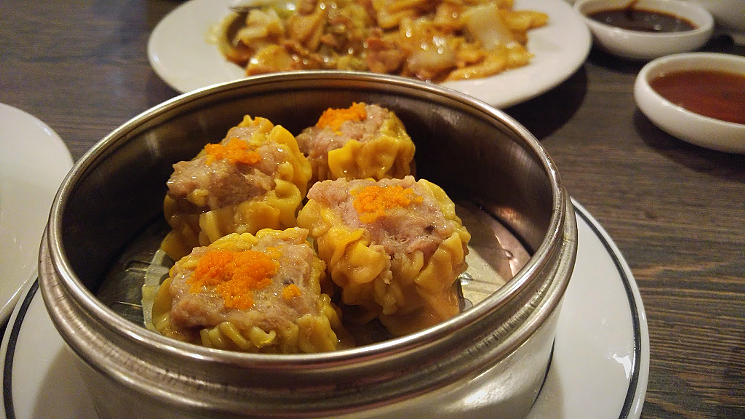
Shumai dumplings are a highlight of the all-day dim sum menu at Mesa's new Dim Sum Cafe.
Patricia Escarcega
Sheila Wang offers me freshly-fried jian dui — perfectly round sesame balls filled with a soft red bean paste. The sweet-savory treats are beautifully hot and crisp on the outside, and pleasantly airy and sweet on the inside.
Sesame balls are a staple treat of Lunar New Year, she tells me, which this year begins on February 16. They are a special menu item that the restaurant is serving expressly for New Year.
Wang, a native of Shanghai, is the owner of Dim Sum Café in Mesa. She runs the restaurant with her brother, Diang, the restaurant’s head chef.
Dim Sum Café opened last summer, offering something that’s still hard to find around metro Phoenix: a casual, all-day spot to fill up on bite-size dim sum snacks.
The “Chinese brunch” tradition of dim sum — the Chinese characters translate roughly to “touch the heart” — typically features small bite-sized portions of food served in steamer baskets or on small plates.
Dim sum originated in southern China, and it’s become most closely associated with Hong Kong, which is widely acknowledged as the dim sum capital of the world. In Cantonese tradition, dim sum is often called yum cha, which translates to “drink tea.” Endless cups of tea is a big part of a traditional Cantonese dim sum.
Dim sum has a long history in the U.S., and it’s become a well-established weekend tradition in major American cities like San Francisco and New York.
For a city of its size, the dim sum scene in metro Phoenix is pretty lean. The opening of a new dim sum restaurant in metro Phoenix, then, is always a pretty big deal.
You won’t find any roving dim sum carts at Dim Sum Cafe. Most items are prepared to order in the kitchen. But you will find familiar snacks like chicken feet and shumai dumplings.
Wang tells me that many of her customers are dim sum newbies, which is why she offers her guests a brief “overview” of the menu. She explains the ordering process, describes ingredients, and sometimes even offers a little background history of some dishes.
Does she ever tire of having to explain?
“I’m actually very happy to do so,” she says. “I think the trend for restaurants now is not just thinking about food as something to fill people’s stomach. People want to know the culture behind the food. Dim sum is art, you know?”
Wang hopes that Dim Sum Café eventually becomes “the first thing people think about when they think about dim sum.”
Launching the restaurant hasn’t been easy, though.
She’s describes a dilemma that faces many Chinese restaurateurs: designing a menu that will appeal to both Chinese and non-Chinese clientele.
“I actually have zero restaurant experience,” Wang says. “So, especially in the first three months, I called all of my friends, asking for help and advice. I was running around in a circle for months and months. Finally, I realized we needed not just dim sum, but also entrees on the menu.”
These days, there’s more pressure than ever on restaurateurs like Wang. More non-Chinese diners are showing an interest in the provenance and history of “ethnic” dishes. Menus have to deliver popular and frequently requested dishes, while also satisfying a growing consumer demand for “authenticity.” This can lead to wide-ranging menus that glean from many regional styles.
“I tell people that we have dim sum, and that dim sum is from Canton and Hong Kong. But we also blend it with a little bit of Shanghai, like our Shanghai soup dumplings,” Wang says.
“Now we’ve introduced some northern-style dim sum, like pan-fried beef buns and pot stickers. When it comes to the entrees, we mainly focus on Shanghai-style dishes. Maybe one or two Cantonese dishes. And some Sichuan,” she says.
Dim Sum Café’s latest menu, she tells me, is at “least the fifth or sixth edition.”
Wang may not have previous restaurant experience, but she has an otherwise long and impressive resume. Her training is in IT. She’s worked as an application architect and consultant at Fortune 500 companies. She’s also a licensed real estate agent.
“Having a restaurant was always my brother’s dream. My dream was to go to Silicon Valley and work for a start-up company,” she says.
Wang, who came to the U.S. in 1988 as a college student, moved to Arizona in 2000. She came to metro Phoenix on the advice of a friend, who told her it would be wise to “establish” herself in Phoenix before moving on to the Bay Area.
Something unexpected happened, though: She fell in love with Phoenix.
“The real estate is reasonable, and the weather is usually great,” she says.
Wang lives in Chandler, and she’s gotten a big kick out of seeing the East Valley grow.
“I’ve been here 18 years,” she tells me. “You know where the 101 and Ray is? There was nothing there. Now we have a Whole Foods. Everything is built up now. It’s amazing.”
Working as a real estate agent has put her on the front lines of that growth — and given her insight into why East Valley cities like Chandler and Gilbert have become a magnet for Asian and Asian-American newcomers.
Wang, ever the real estate agent, lists off the East Valley’s many highly desirable amenities: good schools. Tech companies like Intel. She also echoes a sentiment shared by many people I’ve talked to: Housing is so much more affordable here than in neighboring California.
She believes Chandler’s growth is closely tied to its status as a “technology city.”
Intel, the tech giant, employs more than 10,000 workers at its Chandler facility. Intel also maintains various offices and facilities in China, and its earned a reputation for bringing aboard highly skilled engineers and other tech workers from China and India.
Wang says the East Valley has become particularly desirable among Chinese and Chinese-American buyers.
“I don’t want to represent all Asians, but most Chinese love technology. So, they see Chandler has a lot of tech, and buy real estate here,” Wang says.
“There’s also Lee Lee’s supermarket nearby, so many people feel it’s more convenient to live in the East Valley.”
Supermarkets and shopping plazas come up a lot when you talk about the Valley’s growing Chinese restaurant scene.
Mekong Plaza, Lee Lee’s Market, and Arizona International Market have become important neighborhood anchors along Dobson Road.
Adam Yee, the young food-obsessed scientist, says that supermarkets can be a crucial part of growing a new food scene.
“What a supermarket can do is get a supply chain going. They make it so that you can actually afford interesting ingredients and bring them to your restaurant,” he says.
He can’t wait for H-Mart to open, the new Korean megamarket that’s projected to debut sometime this year on Dobson Road. He’s whetting his appetite for all the new Korean restaurants he predicts will open around the new market.
Wang also believes the East Valley restaurant scene is being shaped by ASU’s international student population.
“A lot of Asian restaurants are opening up, especially around Tempe and Mesa, because of ASU. There’s tons of international students in ASU, and many places want to provide service and food for students,” Wang tells me.
ASU professor Wei Li, for her part, says that ASU students are “definitely a contributing factor.”
Chinese students now represent the fastest growing international student demographic on U.S. campuses. According to a recent report from the Institute of International Education, more than 304,000 Chinese students enrolled in U.S. colleges and universities in the 2014-15 academic year. That represents almost a five-fold increase from a decade earlier.
“I don’t have the updated numbers, but last fall, ASU alone had more than 4,000 Chinese international students,” Dr. Li says.
How does that compare to other big public universities?
It’s hard to tell. Last year, Foreign Policy Magazine created a ranking of the “most Chinese” college campuses in the U.S. by collecting Department of Homeland Security statistics on student visas. It’s an imperfect metric, but it offers a fuzzy snapshot of what Chinese student enrollment looks like across the country.
According to that analysis, ASU ranks 15 in the nation out of the country’s 25 top colleges for Chinese student enrollment. (ASU’s International Admissions office did not respond to New Times’ interview request).
Dr. Li tells me that she has been, in the past, “a little bit cautious” about making a connection between ASU’s Chinese student population and the surge in new East Valley Chinese restaurants.
But now she’s certain that there’s a connection.
“The overall trend is that more and more Chinese students are undergraduate students,” she says.
Twenty years ago, she says, when she was a graduate student at the University of Southern California, it was difficult for Chinese students to study in the U.S. without university funding.
Things are different now. The Chinese economy is booming, which means more Chinese families are able to spend top dollar on their children’s education.
“The overwhelming majority of undergraduate students in schools like ASU — their family finances their studies,” Dr. Li says. “These students just left their hometown or their home city in China, and they have the desire to taste their hometown food, or other cuisines that they’re familiar with. And they now have the financial means to do so.”
Zhang, the ASU student who loves Shaanxi Garden, says that ASU students from China will continue to shape the East Valley scene — as long they continue to pick ASU for their studies.
She also believes the international student population from China is being vastly under served.
“The authentic Chinese food scene will certainly expand as long as a substantial number of Chinese students choose ASU,” she says.
“One reason is ASU cafeteria doesn’t provide any kind of Chinese food. It’s a shame.”
That means that roughly 4,000 Chinese students regularly find themselves having to hunt down dinner, she tells me.
It’s a “pretty good niche market” for entrepreneurs looking to fill a demand, she says.
She’s noticed that Chinese restaurants that were previously in Chandler and Mesa are now moving closer to ASU’s Tempe campus.
More interestingly, she says, the relatively slim pickings around campus has given life to a “hidden scene.”
She describes a sort of free-for-all culinary scene buoyed by one-person restaurants. Intrepid self-starters around campus are meeting the demand for more homestyle Chinese food by selling home-cooked food via apps like Wechat, she says.
ASU students are looking for “more authentic styles,” she says.
She describes feeling disheartened by American-style Chinese restaurants like PF Chang’s and Panda Express.
If she had to rate a place like Panda Express on Yelp, she tells me, she would be forced to give it only one star.
Chou’s Kitchen in Chandler is an unassuming-looking restaurant in a sleepy Chandler strip mall. The humble eatery, though, has been a modern pioneer of Chinese cooking in metro Phoenix. The restaurant has introduced many Valley diners to the hearty fare of northeastern China’s Dongbei region.
Sunny Zhao, who runs Chou’s Kitchen with founding partner Lulu Zhou, is a smiling, doting presence at the Chandler location on most days (Chou’s Kitchen opened a second location in Tempe in 2016).
Zhao is in her 50s, but she has the smooth, unlined face of somebody who’s barely crossed into middle age.
Zhao has worked in restaurants for most of her adult life. Before she partnered with Zhou in 2014, she worked at a Subway restaurant for six years. Before that, she ran two Chinese restaurants in Falls Church, Virginia.
Her husband’s work brought her to metro Phoenix, and she met Lulu Zhou one day while having lunch at Chou’s Kitchen. The women bonded immediately — they’re both natives of Dalian, a major port city located on the Liaodong Peninsula in northeastern China.
Zhao shows me pictures of her most recent Dalian vacation on her smartphone. Every crisp frame reveals a cityscape of impressive fountains, gardens, and seaside coves.
Zhao works seven days a week, so that she can take a monthlong break in the summer to visit her parents and mother-in-law in China.
As with other Chinese restaurateurs, there’s nothing precious about the way she does business. She loves introducing diners to her native cuisine — especially dishes like boiled dumplings, fried buns, and meat pies. But she’s more than willing to accommodate diners craving something different, or perhaps something more familiar.
“Before, we didn’t have vegetable spring rolls. A lot of customers asked for them, so we added it to the menu. We don’t want people to come here and say, ‘Oh, I want General Tso’s chicken, but you don’t have it,’ and then leave … If we have [the ingredients], I can make it,” she says.
More often than not, though, Chou’s clientele comes expressly for the restaurant’s regional specialties.
“They come here because they want to eat what they eat in China,” she tells me.
Intel has a facility in her hometown of Dalian, she tells me.
Sometimes, local Intel workers — those previously based in Dalian — will come to her restaurant. They come because they miss the food they used to eat in her hometown.
“Every summer before I go to China, some employee from Intel tells me: ‘Sunny you must try — and they tell me which food to try in Dalian. That’s very weird ... They tell me about my own hometown. That’s so interesting, right?”
Chou’s Kitchen, by any measure, is a successful restaurant. It has spawned a second location, and it’s earned national acclaim (Travel + Leisure singled out the restaurant on their “Best Chinese Restaurants in the U.S.” list a few years ago).
But perhaps the most telling measure of Chou’s success is the simple fact that Sunny Zhao hasn’t had a single free weekend to spend with her husband in ages.
“My husband has days off on Saturday and Sunday, but I cannot spend it with him,” she says. “On the weekend, the restaurant is very busy. I mean, you need to take care of the business, you know?”

